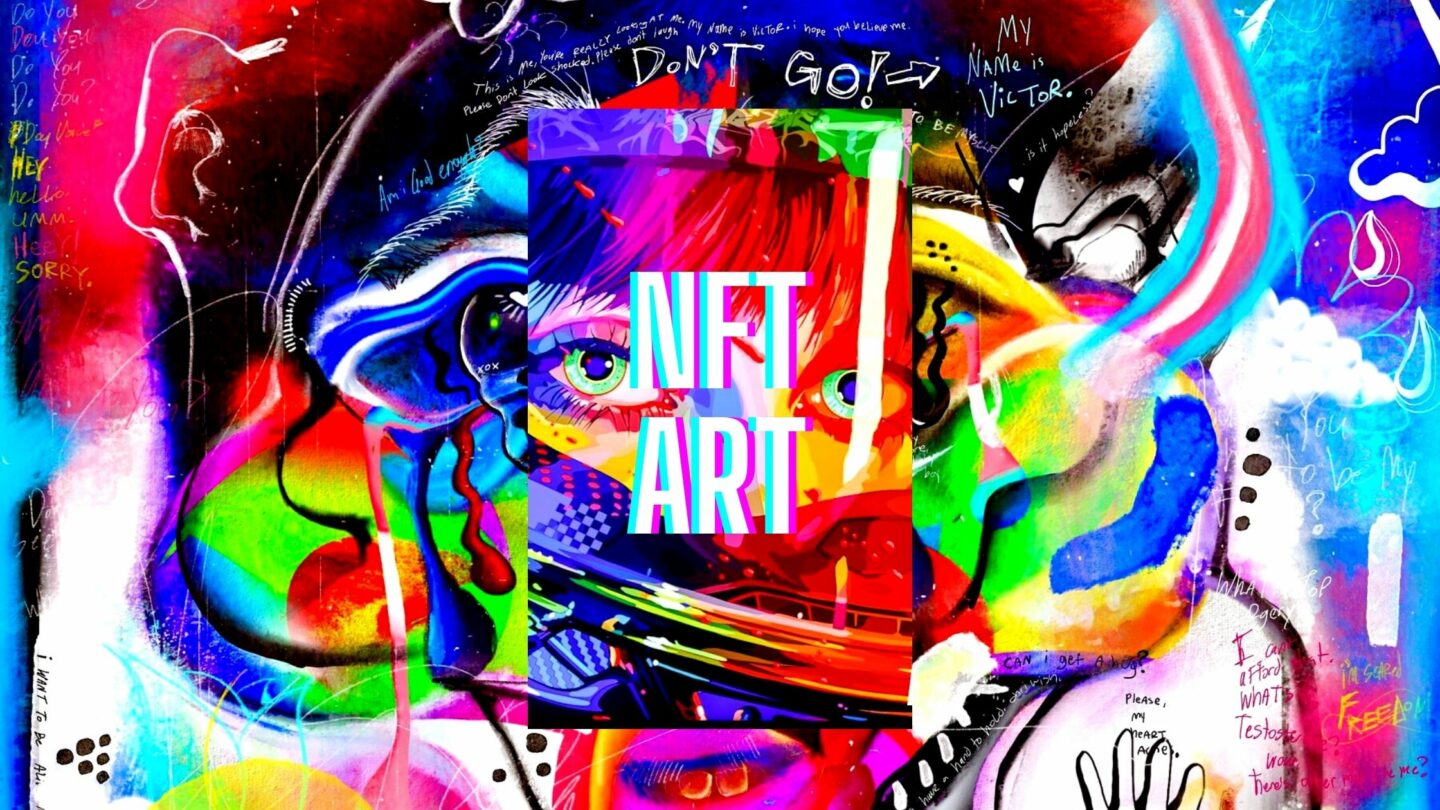

TL;DR
• NFTs are digital assets that use blockchain technology to verify ownership and authenticity, making them unique and valuable assets.
• NFT art is a new form of digital art that is created, stored, and sold using blockchain technology.
• NFTs are changing the way that art is bought and sold, offering new revenue streams and opportunities for artists.
• NFTs allow for digital art to be owned and sold in the same way as a physical art, providing a transparent and secure way to verify ownership and authenticity.
• NFTs have been criticised for their environmental impact and their potential to promote elitism and exclusivity in the art world.
• Collaborating with artists on NFT projects can be a win-win for both brands and artists, creating unique and innovative NFTs that represent the brand’s identity and values while also engaging with the Web3 community in a meaningful way.
• Using Non-Fungies Curators (NFC) as an NFT launchpad for artists to ease the way for them to enter the Web3 and NFT space
Digital art has struggled to gain the same recognition and value as traditional art forms, but the emergence of Non-Fungible Tokens (NFTs) is changing that. NFTs are digital assets that use blockchain technology to verify ownership and authenticity, making them a unique and valuable asset. In recent years, NFTs have become a valuable tool for artists, allowing them to sell unique digital art pieces in a secure and transparent way.
What is NFT Art?
NFT art is a new form of digital art that is created, stored, and sold using blockchain technology. Unlike traditional art forms, NFT art is entirely digital and can be easily reproduced and shared. However, the use of blockchain technology allows NFTs to be verified and authenticated, making them a unique and valuable asset. NFT art can take many forms, including digital paintings, photographs, and videos.
The Birth of Art NFTs
Non-Fungible Tokens (NFTs) are digital assets that are unique and cannot be replicated. NFTs are created using blockchain technology, which allows for ownership and authenticity to be verified. NFTs have become increasingly popular in the art world, as they allow artists to sell unique digital art pieces in a secure and transparent way.
NFTs are changing the way that art is bought and sold, offering new revenue streams and opportunities for artists. Some of the ways that NFTs are revolutionising the art world include:
• Digital Ownership and Scarcity: NFTs allow for digital art to be owned and sold in the same way as physical art. This means that digital art can be scarce, just like physical art, which can increase its value.
• New Revenue Streams for Artists: NFTs allow for artists to sell their digital art directly to collectors, without the need for traditional galleries or auction houses. This can provide new revenue streams for artists and allow them to retain more control over their work.
• Transparency and Authenticity: NFTs provide a transparent and secure way to verify ownership and authenticity, which can help to prevent fraud and protect artists’ intellectual property.
One of the most significant advantages of NFTs is that they allow artists to monetize their digital creations in ways that were previously impossible. Digital art has long been undervalued because of its ease of reproduction and the difficulty of proving ownership and authenticity. NFTs solve both of these problems, allowing artists to sell unique digital art pieces that are verifiably owned by the buyer.
Examples
Everydays: The First 5000 Days by Beeple, which sold for a record-breaking $69 million at Christie’s auction house
CryptoKitties a collection of digital cat images that became so popular in 2017 that they caused congestion on the Ethereum blockchain.
Grimes Artwork a collection sold by the musician Grimes for nearly $6 million
Criticisms and Challenges
While NFTs offer many benefits for artists and collectors, they also pose challenges and concerns. These challenges can span across the spectrum, however, as this technology is fairly new and the Web3 space is still evolving alot of these challenges are being tackled on regular basis. Some of the challenges that remain in the market are linked to the following:
Environmental Impact: The creation and sale of NFTs require a significant amount of energy, which can have a negative impact on the environment. Critics argue that the environmental impact of NFTs outweighs their benefits. This however, depends completely on the blockchain that is utilised for example Ethereum and Polygon offer a cheap way to mint NFTs without the requirement of electricity as they use Proof-of-Stake consensus which doesn’t need immense electricity power to run.
Elitism and Exclusivity: NFTs are often sold for large sums of money, which can make them inaccessible to many people. Some argue that NFTs promote elitism and exclusivity in the art world. This concept surfaced mainly when Bored Apes Yacht Club and Crypto Punks on Ethereum started to gain major traction, suddenly each Bored Ape NFT started selling at an average of $200,000+ with a limited collection of 10,000 NFTs creating a high-barrier of entry to some people. However, NFTs are not all meant to be for the common public and this shouldn’t push people away from learning about the technology and adapting it.
Web2 to Web3 Adaption: Another big issue with NFTs is that they require technological knowledge so it has always been a challenge to onboard regular joe to the NFT and Web3 space. This transformation is taking place slowly and it can only be achieved with a wide-scope education to the public, just like the internet changed the lives of everyone, the Web3 space has a potential to continue this growth trajectory and enhance future generations lives through ownership.
The Future of Art NFTs
The future of crypto art and NFTs remains uncertain, but many believe that they will continue to shape the art world in the coming years. While there are concerns about environmental impacts, elitism, and barrier of entry due to educating the public, NFTs offer new opportunities for artists and collectors, and are changing the way that art is bought and sold. As the technology continues to evolve and become more widely adopted, it will be interesting to see how it impacts the art world and the broader cultural landscape.
One of the more interesting additions to the Art NFT world is the introduction of Phygital NFTs which is a hybrid between physical and digital, meaning that the ownership can be confirmed and authenticated through the NFTs on the blockchain and the physical artwork can be held either with the owner or somewhere else completely. Theis concept is still on the raise and alot of companies are looking to implement unique ways to benefit from it.
Phygital Art NFTs
Phygital art refers to digital art that is designed to interact with the physical world in some way. Phygital art NFTs are digital assets that use blockchain technology to verify ownership and authenticity. Some examples of phygital art NFTs include:
“Mars House” by Krista Kim: This NFT represents a digital rendering of a futuristic home designed by artist Krista Kim. The NFT also includes a physical replica of the house, which was created using 3D printing technology.
“The First 5000 Days” by Beeple: While not strictly a phygital art NFT, “The First 5000 Days” includes a unique physical element. The NFT was sold with a digital frame designed by the artist, which was intended to be displayed alongside the digital artwork.
“Augmented Archipelago” by David McLeod: This NFT series includes a set of digital artworks that are designed to be displayed on screens alongside physical objects, such as plants or rocks. The combination of the digital and physical elements creates a unique and immersive viewing experience.
Brands Collaborating with Artists to Create Art NFTs
The rise of NFTs has opened up new opportunities for brands to engage with consumers in the Web3 space. Collaborating with artists to create branded NFTs has emerged as a popular strategy for brands to showcase their values and identity, while also tapping into the growing audience within the digital art world. One of the most significant advantages of collaborating with artists on NFT projects is the opportunity to create unique and innovative digital assets that represent a brand. By working with artists who are familiar with the space, brands can ensure that their NFTs are well-designed and relevant to the Web3 community. This can help brands to stand out in a crowded digital space and foster deeper connections with consumers.
Moreover, incorporating a brand’s identity and values into NFTs can create a unique and authentic representation of the brand in the digital space. This can help to differentiate a brand from its competitors and build stronger relationships with consumers. By partnering with artists who have strong followings and reputations in the art world, brands can also tap into new audiences and build relationships with potential customers. Collaborating with artists on NFT projects can also be beneficial for artists. By working with brands, artists can gain exposure to new audiences and potentially increase their revenue streams. They can also gain access to resources and expertise that can help them to create more ambitious and innovative projects. Similarly, brands can also benefit from the creative and technical expertise that artists bring to the table.
Overall, collaborating with artists on NFT projects can be a win-win for both brands and artists. By working together, they can create unique and innovative NFTs that represent the brand’s identity and values while also engaging with the Web3 community in a meaningful way. As the digital art world and the Web3 space continue to evolve, collaborating with artists on NFT projects can be an effective way for brands to position themselves for success in this new era of digital engagement.
Offering Artists an Easier Way to Create Art NFTs
There is no doubt that a lot of artists are still looking for ways to showcase their work to the public and benefit from the concept of NFTs. However, these artists find it difficult to explore the Web3 space and usually give up on it, losing an opportunity to grow and showcase their passion. To make it easier for these artists to enter the world of Web3 and NFTs a simple solution that is user-friendly can create wonders by helping artists focus on their artwork without the requirement to learn all the technical details around creating and minting NFTs onto the blockchain.
Introducing Non-Fungies Curators (NFC) a Launchpad for Artists
Non-Fungies Curators is simply a launchpad that empowers artists and helps them launch their artwork to the world through NFTs. As a launchpad NFC allows artists to focus purely on their skills and passion, while they do all the work in terms of creating a branding, website, domain hosting, NFT creation, NFT marketing and launch, and marketplace listings. This way any artist in the world will have the opportunity to launch their own Art NFT collection with zero-knowledge about the underlying blockchain technology.
Non-Fungies Curators already collaborated with a couple of up-and-coming artists to launch their NFT collections, Top NFT Pioneers Collection which is a collection of 100 NFTs showcasing the top NFT countries by volume. Along with Greed is Good Collection which is a collection of 5,000 NFTs highlighting artwork about countries that look to gain from being greedy.
Growing and cultivating the artists talent adds value to the whole Web3 space, which creates a better and stronger communities for everyone to express themselves within.
